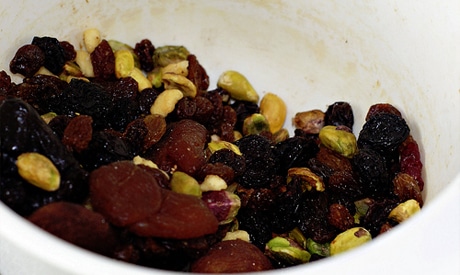
As a child, my only
exposure to dried fruit was in the fruitcake my aunt would make every year
around the holidays and the braided sweet bread my grandmother lovingly
prepared for the same season. For me, those sickly sweet, artificially colored
bits of stickiness were enough to turn me off to dried fruit for decades. Then
as an adult, I joined a natural foods cooperative and someone handed me a dried
mango during a food demonstration. That’s when I discovered what dried fruit is
supposed to look and taste like, and the difference was amazing. Read more about artificial colors
By that time, grandma had
passed on and my aunt didn’t make holiday
fruitcakes anymore. Personally I’m not much
of a baker, so I probably won’t be trying my aunt’s recipe. But when I want a
nutritious, convenient and tasty treat, there’s nothing quite like dried fruit.
So what should you look for when buying dried fruit?
It’s really quite simple.
First of all, just about every common fruit-and some not so common ones-are
available in dried form. From apples and bananas to goji
berries and jack fruit, you can pamper your taste
buds. There are at least as many different types of dried fruit as there are
days in a month, so you can try a different one every day and find your
favorites.
Second, and most important,
read the label. Look for organic (non-GMO) brands, whether you are buying the
fruit packaged from a store or online or from a bulk foods bin. The only words
appearing after “Ingredients” on the label should be “organic” and the name of
the fruit. Period.
Read more about why you should avoid GMOs
Some brands of dried fruit
have added sugars and sulfites,
a preservative that can appear on packaging under a variety of names. One label
I recently examined from a large retailer, for example, listed dried mango
followed by powdered sugar (sugar and cornstarch), sugar, and sodium
metabisulfite. This latter ingredient is a type of sulfite and is also used as
a bleaching agent in the making of paper and textiles and in wine
making.
Metabisulfite may cause
breathing difficulties and other allergic reactions in people who have asthma
or who are sensitive to sulfites. Another common sulfite found in dried fruits
is sulfur
dioxide, which can cause similar adverse reactions.
According to the Food and
Drug Administration (FDA), any food or beverage that
contains 10 parts per million of sulfites must state on its label that the item
contains the preservative, but the amount does not have to be given. You can
avoid any worries by simply purchasing 100% natural organic dried fruits.
Another option is to make your own organic dried
fruit.
One benefit of
preservatives is that they extend the shelf life of foods. Although it’s true
organic dried fruits will not last as long on your pantry shelf as the ones
that contain preservatives, store any excess in tightly sealed freezer bags and
put them in the freezer for up to 12 months. Chances are you’ll finish your
dried fruit long before that time is up!
Photo Credit: FraserElliot




